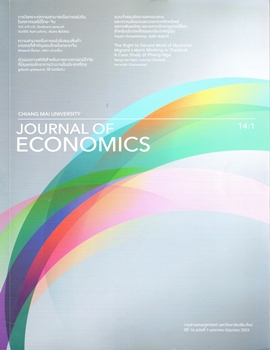ความสามารถในการแข่งขันของสินค้าเกษตรที่สำคัญของไทยในตลาดจีน
Keywords:
Competitiveness, Thai Agricultural Commodities, Chinese MarketAbstract
The aim of this article is to study the competitiveness of Thai agricultural commodities in the Chinese market the growth of which may benefit Thai agriculture.
The commodities studied cover rice, tapioca, sugar, fruits and rubber. Competitiveness is measured by market share, Concentration Ratio Index, Trend of Export, RCA, Dynamic RCA and Competitiveness effect from CMS model.
The results show declining competitiveness in rice, tapioca, sugar and natural rubber but increasing in compound rubber, vulcanized rubber, tapioca starch and fruits. Thai rice is found to be less competitive because of competition with local Chinese long-grain rice. Thailand competitiveness also suffered from the malpractice of mixing Thai Hommali rice with other varieties leading to loss of consumers’ confidence.
The competitiveness of Thai tapioca was lessened by the outbreak of “Mealy Bug”. The shrinkage of export market of sugar was due to increase of the capacity production of sugarcane in China including investment from Thailand. For Thai natural rubber a structural change in China’s imports. A shift in demand for rubber smoked sheets to rubber block had reduced competitiveness in natural rubber sheets. Compound rubber appeared to be the only bright spot for rubber market in China. Vulcanized rubber was less competitive in the last 2 -3 years.
Downloads
Issue
Section
License
All opinions and contents in the CMJE are the responsibility of the author(s). Chiang Mai University Journal of Economics reserves the copyright for all published materials. Papers may not be reproduced in any form without the written permission from Chiang Mai University Journal of Economics.
ข้อคิดเห็นที่ปรากฏและแสดงในเนื้อหาบทความต่างๆในวารสารเศรษฐศาสตร์มหาวิทยาลัยเชียงใหม่ ถือเป็นความเห็นและความรับผิดชอบโดยตรงของผู้เขียนบทความนั้นๆ มิใช่เป็นความเห็นและความรับผิดชอบใดๆของวารสารเศรษฐศาสตร์ มหาวิทยาลัยเชียงใหม่
บทความ เนื้อหา และข้อมูล ฯลฯ ในวารสารเศรษฐศาสตร์มหาวิทยาลัยเชียงใหม่ ถือเป็นลิขสิทธิ์เฉพาะของคณะเศรษฐศาสตร์มหาวิทยาลัยเชียงใหม่ หากบุคคลหรือหน่วยงานใดต้องการนำทั้งหมดหรือส่วนหนึ่งส่วนใดไปเผยแพร่ต่อหรือเพื่อกระทำการใดๆ จะต้องได้รับอนุญาตเป็นลายลักษณ์อักษร จากวารสารเศรษฐศาสตร์ มหาวิทยาลัยเชียงใหม่






